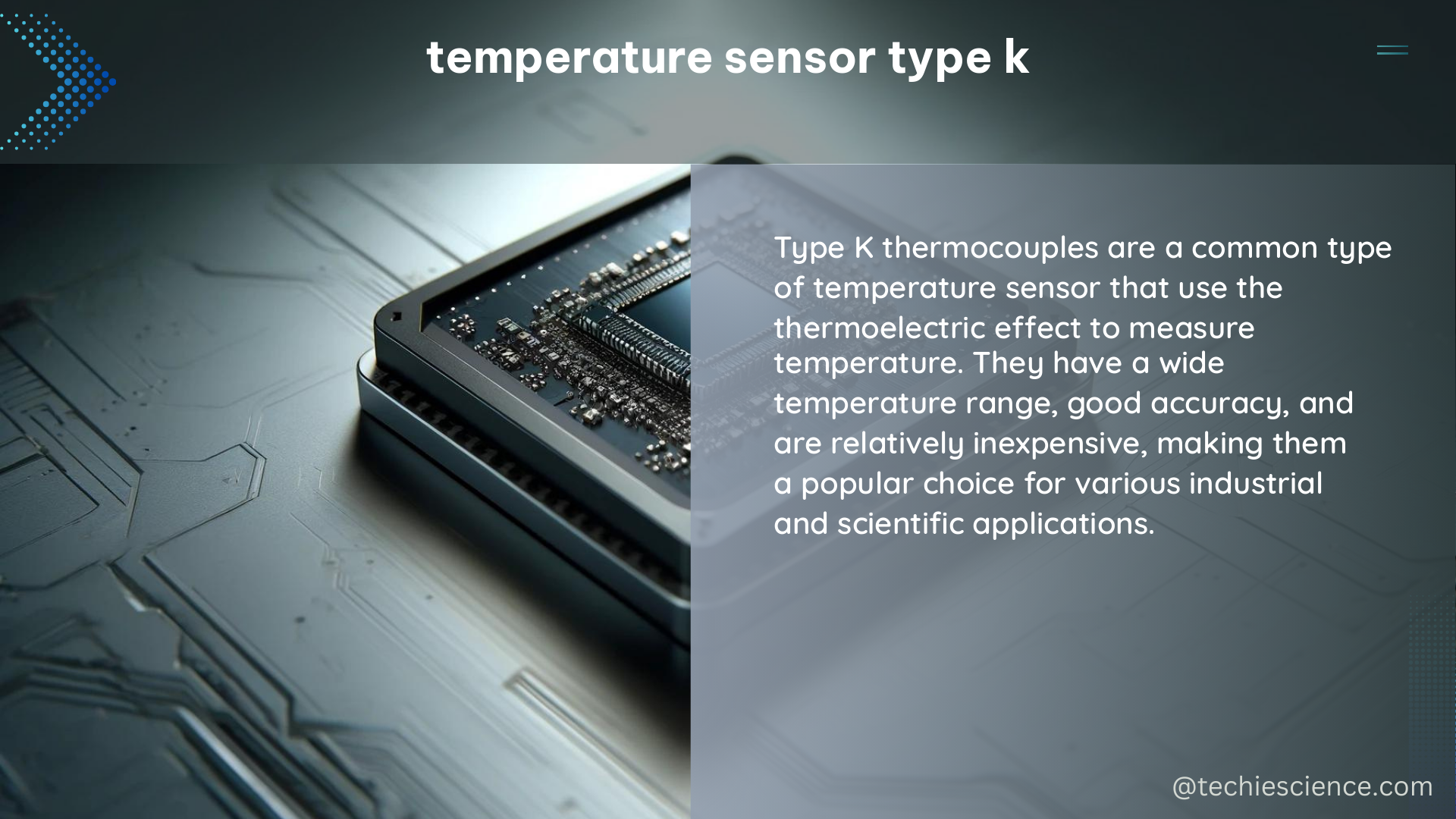Temperature Sensor Type K, also known as Chromel-Alumel thermocouple, is a widely used temperature sensor due to its versatility, precision, and wide temperature measurement range. It is composed of two dissimilar metal alloys, Chromel (Nickel-Chromium) and Alumel (Nickel-Aluminum), which generate a voltage proportional to the temperature difference between the junction of the two metals.
Technical Specifications of Type K Thermocouples
-
Temperature Range: Type K thermocouples can measure temperatures from -200°C (-328°F) to 1260°C (2300°F), making them suitable for a wide range of applications, from cryogenic systems to high-temperature industrial processes.
-
Accuracy: The standard limits of error for Type K thermocouples are ±2.2°C (±4°F) from -50°C to 350°C (±58°F to 662°F) and ±0.75% of the reading above 350°C (662°F). However, higher accuracy sensors with tolerances as low as ±0.5°C (±0.9°F) are available, particularly for precision applications.
-
Response Time: The response time of Type K thermocouples is relatively fast, with a time constant of typically 0.5 to 5 seconds, depending on the sensor design and the surrounding medium. The response time can be affected by the mass and thermal conductivity of the material surrounding the sensor.
-
Stability: Type K thermocouples are known for their stability and long-term reliability, with a typical drift of less than 0.1% per 1000 hours of use at 1100°C (2012°F). However, their accuracy can drift over time due to material aging and contamination. Regular calibration is recommended to maintain accuracy.
-
Interchangeability: Type K thermocouples are interchangeable, meaning that different sensors can be used in the same application without significant changes in the measured temperature. However, it is important to ensure that the sensors are calibrated to the same standard to maintain accuracy.
-
Signal Output: Type K thermocouples generate a voltage output that is proportional to the temperature difference between the measurement junction and the reference junction. The voltage output is typically in the range of 40 to 60 µV/°C (22 to 33 µV/°F), with a sensitivity of approximately 41 µV/°C (23 µV/°F) at 0°C (32°F).
-
Environmental Considerations: Type K thermocouples are suitable for use in various environments, including high-temperature and corrosive applications. However, the sensor wire must be protected from physical damage and contamination to ensure accuracy and longevity. The maximum recommended continuous use temperature for Type K thermocouples is 1260°C (2300°F), with short-term excursions up to 1370°C (2500°F) possible.
DIY Temperature Sensor Type K

Building a DIY temperature sensor Type K can be a rewarding project for hobbyists and professionals alike. Here’s a step-by-step guide to help you get started:
Materials Needed
- Type K thermocouple wire: The wire is typically made of Chromel (positive) and Alumel (negative) alloys, with a diameter ranging from 0.5 mm to 3.2 mm (0.020 to 0.125 inches).
- Thermocouple connector or terminal block: This is used to connect the thermocouple wire to the measurement device.
- Multimeter or data logger: This is used to measure the voltage output of the thermocouple.
- Insulation material: Heat shrink tubing or other insulation is used to protect the sensor wire from physical damage and contamination.
- (Optional) Thermocouple extension wire: This can be used to extend the sensor wire to the measurement device, if needed.
Construction Steps
- Prepare the Thermocouple Wire: Strip the insulation from the ends of the thermocouple wire, exposing the Chromel and Alumel conductors. Twist the conductors together to form the measurement junction.
- Connect the Thermocouple Wire: Connect the thermocouple wire to a thermocouple connector or terminal block, ensuring that the polarity of the wires is correct to avoid measurement errors.
- Insulate the Sensor Wire: Protect the sensor wire from physical damage and contamination by covering it with insulation material, such as heat shrink tubing.
- Connect the Thermocouple to a Multimeter or Data Logger: Connect the thermocouple to a multimeter or data logger to measure the voltage output. Ensure that the multimeter or data logger is calibrated to the same standard as the thermocouple to maintain accuracy.
- Test the Sensor: Test the sensor by exposing it to a known temperature source, such as an ice bath or a hot plate, and comparing the measured temperature to the expected temperature.
- Calibrate the Sensor: Calibrate the sensor by adjusting the output to match the expected temperature. Regular calibration is recommended to maintain accuracy, as the sensor’s performance may drift over time due to factors such as material aging and contamination.
By following these steps, you can build a DIY temperature sensor Type K that can be used for a variety of applications, from home automation to industrial process monitoring.
References
- Using K-type Thermocouple to Measure Human Body Temperature
- How to Log Temperature Data from a Type K Thermocouple in Less Than 3 Minutes
- Type K Thermocouple Datasheet
- Understanding K-Type Thermocouples
- Thermocouple Temperature Sensor

The lambdageeks.com Core SME Team is a group of experienced subject matter experts from diverse scientific and technical fields including Physics, Chemistry, Technology,Electronics & Electrical Engineering, Automotive, Mechanical Engineering. Our team collaborates to create high-quality, well-researched articles on a wide range of science and technology topics for the lambdageeks.com website.
All Our Senior SME are having more than 7 Years of experience in the respective fields . They are either Working Industry Professionals or assocaited With different Universities. Refer Our Authors Page to get to know About our Core SMEs.